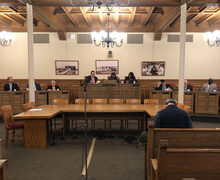‘Run the Redline’ sheds light on the prevalence of redlining, urban renewal projects
Dominic Chiappone | Asst. News Editor
Participants, both running and walking, passed by photos along the route that illustrated the differences in predominantly-Black Syracuse neighborhoods before and after discriminatory infrastructure implementations, like I-81’s construction.
Get the latest Syracuse news delivered right to your inbox.
Subscribe to our newsletter here.
Addressing a crowd of approximately 200 people, Syracuse Deputy Mayor Sharon Owens made her message clear: remember what once stood before you.
“Today, your feet are going to trample over policies that were established to keep Black people down, disenfranchise and destroy their opportunity for generational wealth,” Owens said.
Owens spoke minutes before Syracuse residents started the Run the Redline race Sunday morning. Participants ran along the path of redlining that federal and local government officials implemented to divide the city of Syracuse’s racial communities beginning in the 1930s.
Government officials worked with real estate partners to create the red lines around Syracuse’s predominantly-Black neighborhoods deemed too “risky” for real estate investments. The policies, coupled with the construction of the Interstate 81 viaduct, created decades’ worth of disinvestment and economic decline that Black residents still experience today, said Sally Santangelo, executive director of CNY Fair Housing.
“We had this idea to bring this race into our streets in Syracuse to give us a moment to see those spaces, and understand the impact of those historic practices and policies, and the impact we still feel,” Santangelo said.
CNY Fair Housing, a Syracuse nonprofit organization that advocates against housing discrimination, hosted the event to raise awareness and educate the community about the looming consequences of redlining and urban renewal projects.
Federal projects like I-81 physically divided the predominantly-Black community in the Southside from the eastern portion of the city, which houses Syracuse University and more predominantly white, affluent neighborhoods. The run’s route went along State Street, East Washington Street, East Water Street and East Fayette Street.

The photos along the path for the Run the Redline event were posted on doors to represent the homes and businesses of Syracuse’s Black residents that were taken away by the federal government and local officials.
Dominic Chiappone | Asst. News Editor Position
Vivan Lockwood, who’s lived in Clay for approximately a decade, said the run provided himself and other locals an opportunity to educate themselves about the long-lasting historical impacts of discriminatory housing on the Syracuse area.
Participants, both running and walking, passed by photos along the route that illustrated the differences in predominantly-Black Syracuse neighborhoods before and after discriminatory infrastructure implementations, like I-81’s construction. The photos were posted on doors that Syracuse Habitat for Humanity donated to CNY Fair Housing to represent the homes and businesses of Black residents that were taken away by the federal government and local officials, Santangelo said.
Christina Zhang, a Harry der Boghosian Fellow in SU’s School of Architecture, said she participated to learn more about the city’s complex history and apply that knowledge to her classes. Zhang currently teaches a course at SU where architecture students map urban landscapes, including the 15th Ward, she said.
The visual aids implemented on the run’s path told the widely unknown stories of residents who were directly impacted by the urban renewal and redlining actions, Zhang said.
“It’s awesome to see people tied together by the whole history of redlining and to really get to know it,” Zhang said. “It’s an important part of Syracuse the city … but it’s also my way of getting to know the city and getting to know the topics that are important for the architecture school.”
New York State Senator Rachel May, whose district includes Syracuse, said before the race that redlining and housing discrimination created some of the worst concentrated poverty — specifically Black poverty — in the entire country.
Syracuse had the sixth-highest poverty rate among Black residents of all United States cities with at least 100,000 residents in 2020. Syracuse’s ongoing lead crisis also continues to disproportionately impact Black communities across the city. Roughly 12% of children in the city of Syracuse tested for lead had elevated lead levels, according to data from the Onondaga County Health Department.
Owens said the run came at a critical time following the announced decision to demolish parts of I-81 and build a community grid through the I-81 Viaduct Project, an effort to reverse the harm caused by the creation of the interstate highway in the 1960s.
While Owens acknowledged the community grid project and other city initiatives to address the redlining barriers, she said events like the run remind residents of the past actions that necessitated those remedial projects.
“Putting the information in front of people in this community is brilliant to be able to decipher information and make the right conclusion, and the right conclusion is what happened to this community was criminal,” Owens said.
Published on September 17, 2023 at 11:00 pm
Contact Dominic: dcchiapp@syr.edu | @DominicChiappo2





